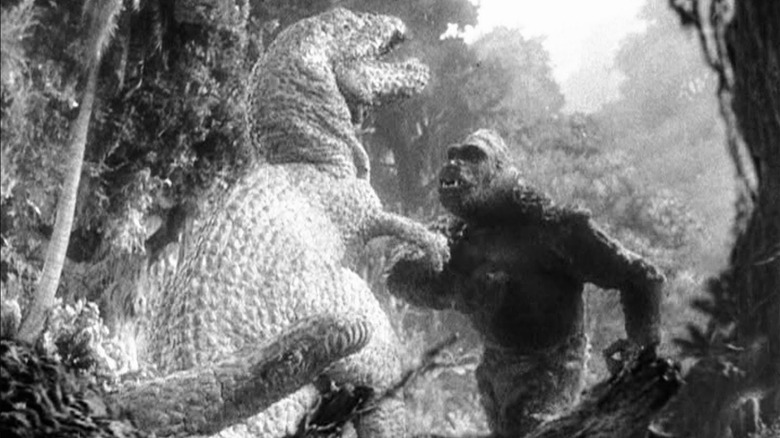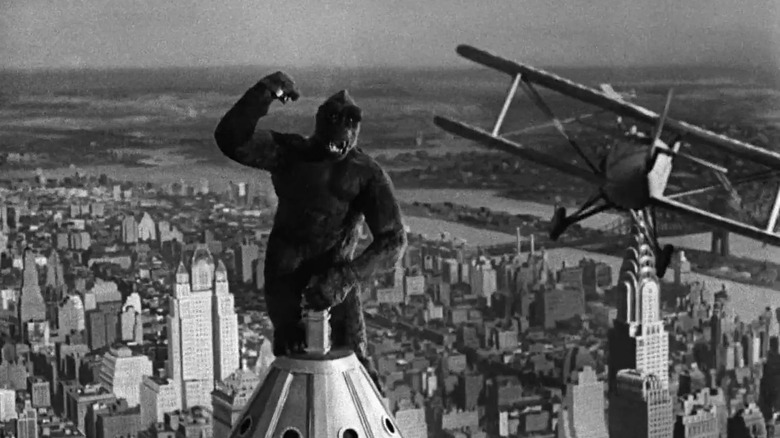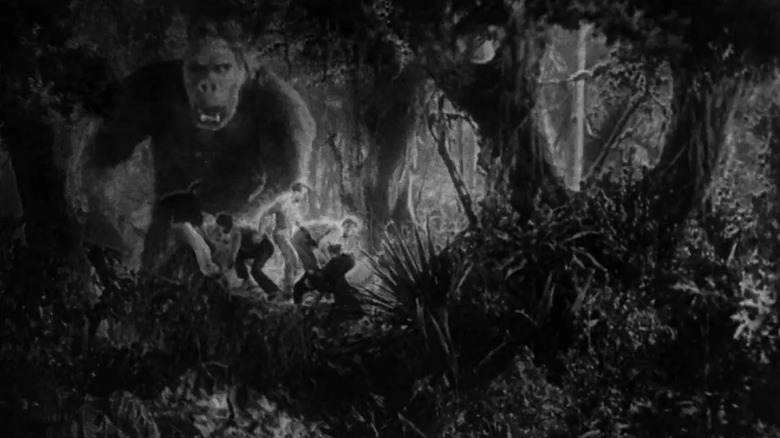Securing Funding For The Original King Kong Was Almost As Impressive As The Film Itself
I loved old monster movies when I was a little kid. I couldn't get enough of bug-eyed mutants, lovestruck fish-men, and giant ants in the drains of Los Angeles. I especially got a thrill from enraged creatures rampaging through a city, so Ray Harryhausen's "20 Million Miles to Earth," "It Came From Beneath the Sea," and "The Beast From 20,000 Fathoms" were particular favorites. I just wanted the destruction to go on and on, and I always cried when the beast died at the end.
If Harryhausen is commonly known as the master of stop-motion animation, giving us such wonderful creations as Talos in "Jason and the Argonauts" and the terrifying Medusa in "Clash of the Titans," he himself was influenced by an earlier special effects master. Willis O'Brien was the guy who gave us the giant gorilla in "King Kong," still one of the greatest creature features ever made almost 90 years later.
Forget the charmless 1976 remake and Peter Jackson's boring three-hour slog, the 1933 original is still the definitive version. Sure, the human characters aren't very engaging and Fay Wray has little to do other than scream her head off, and we spend way too long on the boat at the beginning. But once we set foot on Skull Island, we're off. From that point it's a non-stop adventure, a perfect blend of pathos and peril, bounding from one set piece to the next. At its heart is O'Brien's wonderfully expressive Kong, a rampaging creature really worth rooting for, whether he's battling dinosaurs or swatting biplanes at the famous climax atop the Empire State building. You can see the seams a little – notice how Kong's fur ripples from the animator's touch during the stop-motion process – but he's so charming that we suspend our disbelief, and his tragic demise is still heartbreaking.
As sensational as the story for "King Kong" was, getting the money for the film was tough. There was a Great Depression happening at the time, and cash wasn't all that easy to come by, but producer Merian C. Cooper had a special weapon...
The true inspiration for King Kong
Merian C. Cooper had an adventurous life before he produced and directed "King Kong." After serving as a pilot during World War I and spending time as a Soviet prisoner of war while helping the Polish army fight against Russia (via American-Polish Cooperation Society), he met fellow explorer, filmmaker, and producer Ernest B. Shoedsack. They embarked on a series of intrepid projects together, traveling to Iran to make a documentary about the nomadic Bakhtiari people in "Grass," and heading out to Thailand to film the day-to-day life in the jungle in "Chang." When it came to adapting "The Four Feathers" for the screen, the dauntless filmmakers shot part of it in Sudan to get real footage of local tribes and wildlife (via Britannica).
One of the most common myths about the inception of "King Kong" is that the idea of a giant gorilla attacking New York came to Cooper in a dream, but it is more likely that the inspiration came from the exploits of his adventurer pal, William Douglas Burden.
Burden had traveled to Indonesia with the goal of capturing a Komodo dragon. They were around 10 feet long and capable of eating a whole buffalo for lunch. Burden's nickname for them was "King Komodo." He described Komodo as a remote, mysterious place filled with exotic animals, which may have fed into the design of Skull Island.
Burden returned to New York with three Komodo dragons, where they became a star attraction at the zoo. Yet his scary lizards were upstaged by a stuffed gorilla. Visitors flocked to see this curiosity because, until that point, gorillas had not been seen in North America. The two creatures came together in Cooper's mind, as he later wrote to Burden (via TCM):
"After one of my conversations with you, I thought to myself, why not film my Gorilla ...I also had very firmly in mind to giantize both the Gorilla and your Dragons to make them really huge. However, I always believed in personalizing and focusing attention on one main character and from the very beginning I intended to make it the Gigantic Gorilla, no matter what else I surrounded him with....I had already established him in my mind on a prehistoric island with prehistoric monsters, and I now thought of having him destroyed by the most sophisticated thing I could think of in civilization..."
Cooper had himself a great idea for a movie, but getting it greenlit wasn't easy. No producer would back a gorilla picture shot on location, but then Cooper saw the stop motion work of O'Brien on "Creation," an over-budget production about to get the chop. Maybe this would persuade them...
Willis O'Brien's special effects convince the bean-counters
Willis O'Brien had been making stop motion shorts since 1914, with titles like "The Dinosaur and the Missing Link" and "The Ghost of Slumber Mountain." His impressive effects work led to the feature length "The Lost World," an adaptation of Sir Arthur Conan Doyle's novel. O'Brien was in his element, creating Brontosaurs, Triceratops, and Allosaurs, using clever techniques to put actors in the same frame as his beasts. His dinosaurs ran, ate, and fought, and he also added inflatable bladders so they would even appear to breathe.
"The Lost World" was a hit, and Conan Doyle amazed a gathering of magicians with scenes from the film. The event was covered by a reporter who apparently harbored some possibility that it was real footage (via New York Times). The reporter wrote:
"His monsters of the ancient world or of the new world which he has discovered in the ether, were extraordinarily life-like. If fakes, they were masterpieces... The audience was left strictly to its own conclusions, whether the sober-faced Englishman was making merry with them or was lifting the veil from mysteries penetrated only by those of his school who know the secret of filming elves and ectoplasm and other things unknown by human minds."
The ill-fated "Creation" would be scrapped, but O'Brien's work convinced Cooper that a test piece for his gorilla movie might persuade cash-strapped RKO that it could be done in the studio with special effects rather than location work. The test reel was given the nod and Cooper's model maker, Marcel Delgado, got to work on the gorilla. The first two iterations were off, but the third was perfect. O'Brien made two scenes; one where Kong shakes a log bridge and makes some sailors fall to their deaths, and another where Kong fights an Allosaurus.
O'Brien's work was so good that not only did RKO executives enthusiastically hand over a $500,000 budget, the test scenes also remained as two of the best set pieces in the film. Almost a century later, "King Kong" is still the monster movie all others are measured by.


